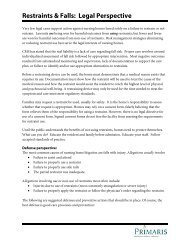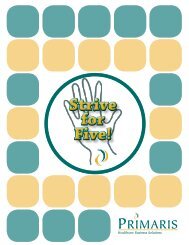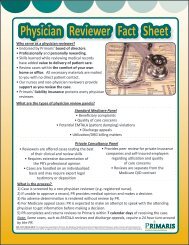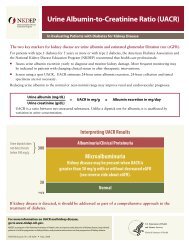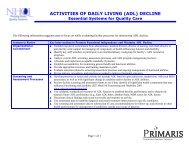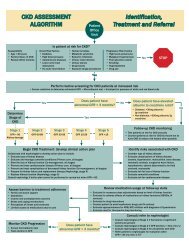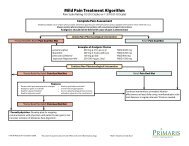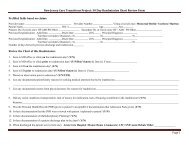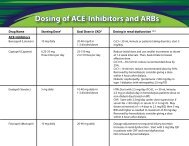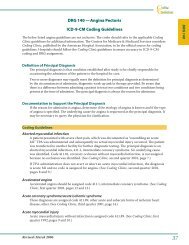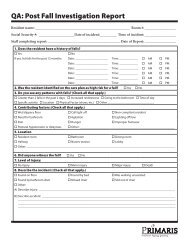Falls: Morse Fall Scale - Primaris
Falls: Morse Fall Scale - Primaris
Falls: Morse Fall Scale - Primaris
You also want an ePaper? Increase the reach of your titles
YUMPU automatically turns print PDFs into web optimized ePapers that Google loves.
<strong><strong>Fall</strong>s</strong>: <strong>Morse</strong> <strong>Fall</strong> <strong>Scale</strong><br />
The <strong>Morse</strong> <strong>Fall</strong> <strong>Scale</strong> (MFS) is a rapid and simple method of assessing a resident’s likelihood of falling. The<br />
MFS is used widely in acute care settings.<br />
Resident name:_________________________________________________________Room #:_____________<br />
Medical record #:_ ________________ Date of assessment:________________ Assessment #:_____________<br />
Variables<br />
Score<br />
History of falling<br />
Secondary diagnosis<br />
Ambulatory aid<br />
IV or IV access<br />
Gait<br />
Mental status<br />
o<br />
o<br />
o<br />
o<br />
o<br />
o<br />
o<br />
o<br />
o<br />
o<br />
o<br />
o<br />
o<br />
o<br />
No (score as 0).. . . . . . . . . . . . . . . . . . . . . . . . . . . . . . . . . . . . . . . . . . . . . . . . . . . . .<br />
Yes (score as 25). . . . . . . . . . . . . . . . . . . . . . . . . . . . . . . . . . . . . . . . . . . . . . . . . . . .<br />
No (score as 0).. . . . . . . . . . . . . . . . . . . . . . . . . . . . . . . . . . . . . . . . . . . . . . . . . . . . .<br />
Yes (score as 15). . . . . . . . . . . . . . . . . . . . . . . . . . . . . . . . . . . . . . . . . . . . . . . . . . . .<br />
Bed rest/nurse assist (score as 0).. . . . . . . . . . . . . . . . . . . . . . . . . . . . . . . . . . . .<br />
Crutches/cane/walker (score as 15).. . . . . . . . . . . . . . . . . . . . . . . . . . . . . . . . .<br />
Furniture (score as 30). . . . . . . . . . . . . . . . . . . . . . . . . . . . . . . . . . . . . . . . . . . . . .<br />
No (score as 0).. . . . . . . . . . . . . . . . . . . . . . . . . . . . . . . . . . . . . . . . . . . . . . . . . . . . .<br />
Yes (score as 20). . . . . . . . . . . . . . . . . . . . . . . . . . . . . . . . . . . . . . . . . . . . . . . . . . . .<br />
Normal/bed rest/immobile (score as 0) .. . . . . . . . . . . . . . . . . . . . . . . . . . . . .<br />
Weak (score as 10) .. . . . . . . . . . . . . . . . . . . . . . . . . . . . . . . . . . . . . . . . . . . . . . . . .<br />
Impaired (score as 20).. . . . . . . . . . . . . . . . . . . . . . . . . . . . . . . . . . . . . . . . . . . . . .<br />
Knows own limits (score as 0). . . . . . . . . . . . . . . . . . . . . . . . . . . . . . . . . . . . . . .<br />
Overestimates or forgets limits (score as 15). . . . . . . . . . . . . . . . . . . . . . . . .<br />
________<br />
________<br />
________<br />
________<br />
________<br />
________<br />
________<br />
________<br />
________<br />
________<br />
________<br />
________<br />
________<br />
________<br />
Total Score<br />
Risk Level MFS Score Action<br />
No risk 0 - 24 Good basic nursing care<br />
Low to moderate risk 25 - 45<br />
High risk 46 +<br />
Implement standard fall prevention interventions using the <strong>Fall</strong>ing<br />
Leaf Program<br />
Implement high-risk fall prevention interventions using the <strong>Fall</strong>ing<br />
Leaf Program<br />
See scoring details on page 2<br />
page 1 of 2
<strong><strong>Fall</strong>s</strong>: <strong>Morse</strong> <strong>Fall</strong> <strong>Scale</strong> page 2 of 2<br />
The items on the scale are scored as follows. The score is then tallied and recorded on the resident’s<br />
assessment/chart. Risk level and recommended actions are identified.<br />
History of <strong>Fall</strong>ing<br />
Note: If a resident falls for the first time, then his/her score immediately increases by 25.<br />
25 Identify all current residents at risk for falls at the beginning of the program using the facility risk assessment<br />
form or a chosen form. This could be done by the charge nurse, supervising registered nurse, or interdisciplinary<br />
care team. Residents with highest risk or residents having multiple falls may be placed in <strong>Fall</strong>ing Leaf precaution.<br />
0 The resident has not fallen, this is scored 0.<br />
Secondary Diagnosis<br />
15 More than one medical diagnosis is listed on the resident’s chart.<br />
0 No more than one medical diagnosis is listed on the resident’s chart.<br />
Ambulatory Aids<br />
30 The resident ambulates clutching onto the furniture for support.<br />
15 The resident uses crutches, a cane, or a walker.<br />
0 The resident walks without a walking aid (even if assisted by a nurse), uses a wheelchair, or is on bed rest and<br />
does not get out of bed at all.<br />
Intravenous Therapy<br />
20 The resident has an intravenous apparatus or heparin lock inserted.<br />
0 The resident does not have an intravenous apparatus or a heparin lock inserted.<br />
Gait<br />
20 The resident has an impaired gait. With an impaired gait, the resident may have difficulty rising from the chair or<br />
attempts to get up by pushing on the arms of the chair or by bouncing. The resident’s head is down, and he/she<br />
watches the ground. Because the residents balance is poor, the resident grasps onto the furniture, a support<br />
person or a walking aid for support and cannot walk without assistance.<br />
10 The resident has a weak gait. With a weak gait, he/she is stooped but able to lift the head while walking without<br />
losing balance. Steps are short and the resident may shuffle.<br />
0 This resident has a normal gait. A normal gait is characterized by the resident walking with the head erect, arms<br />
swinging freely at the side, and striding without hesitation.<br />
Mental Status<br />
When using this scale, mental status is measured by checking the residents self-assessment of his/her own<br />
ability to ambulate. Ask the resident, “Are you able to go to the bathroom alone, or do you need assistance?”<br />
15 The resident’s response is not consistent with nursing orders. If the resident’s response is unrealistic, then he/she<br />
is considered to overestimate his/her own abilities and to be forgetful of limitations.<br />
0 The resident’s reply judging his/her own ability is consistent with the ambulatory order on the plan of care. The<br />
resident is rated as “normal.”<br />
Document available at www.primaris.org<br />
MO-06-32-NH April 2006 This material was prepared by <strong>Primaris</strong>, the Medicare Quality Improvement Organization for Missouri, under<br />
contract with the Centers for Medicare & Medicaid Services (CMS), an agency of the U.S. Department of Health and Human Services. The<br />
contents presented do not necessarily reflect CMS policy.



